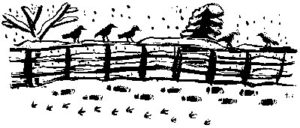 |
| Toki Oshima drawing |
By Grace Oedel
Lately I have been wrestling with the dynamic tension between patience and action. How are we to balance the urgency that motivates us to do our work with the need for rest and rejuvenation?
For farmers, the warm season flies by furiously with chores from before sunrise to after sunset. The beauty, and burden, of farming is that nothing can wait; weeds must be pulled before they go to seed, fruit picked when ripe, cows milked when full, seed threshed when dry. No task can be back-burnered, marked “for later.” Hot, sun-filled days demand that farmers do more, move faster, push harder: A sense of urgency underscores the farming season.
Luckily, nature enforces a rest period. Darkness arrives earlier each day; frost locks the soil up from tines and shovels. Farmers literally cannot continue their tireless work, so they reluctantly head in for the winter.
The Jewish religious calendar is inextricably linked with the agricultural and mirrors the pressure and intensity of the harvest season. In September and October we run a religious marathon, celebrating all the most important holidays of the year back to back. We are asked to push our religious selves as hard as possible: We atone, we celebrate, we fast; some Jewish people even sleep outside for a week. All this activity is compressed into a very short time. We are asked to do more, try harder, and urgently. And then, as for farmers, the intense demand for action grows quiet as darkness comes.
Why do both these agricultural and spiritual cycles demand periods of immense effort and then offer release? What do we gain by pushing ourselves as hard as we can, and then pausing?
We find the answer to this by observing what happens in winter, in our time of rest after the sprint. Only after we have thoroughly pushed ourselves as much as we can are we able to receive the full teachings that rest offers. The winter holidays of Solstice, Christmas and Chanukah all share a single theme: celebrating light at a time of darkness. To give thanks for the miracle of light during a time of darkness stands as a profoundly hopeful, faithful act. And yet this most beautiful act does not happen during the mad rush of the fall holidays. Instead, it arrives in the rest period, in darkness, to teach us that in our rest we are able to give thanks for the most fundamental of gifts – the light.
Similarly for farmers, at least in the North, winter finally provides time to gather with family, enjoy tea with a friend, take up a knitting project. It is impossible to underestimate the deep importance and value of these quotidian, beautiful pleasures that the pause of winter allows. With this spaciousness, farmers begin to leaf through seed catalogs, imagine a new project for the farm next season. New vision and possibility, clarity and hope spring up again.
We pray for light in darkness, we vision a new farm season in times of rest. The real question is not how to extend the summer into the winter, not how to push ourselves as long as possible. Instead, we should ask how to hold on to the tenderness of winter in summer. How can we remember our gratitude for light during a time of abundant sun? How can we hold on to our vision and hope when we are bogged down by chores? How can we cultivate the feeling of peace winter offers through the year?
Grace Oedel was MOFGA’s events coordinator until recently. She now lives in Western Massachusetts.
